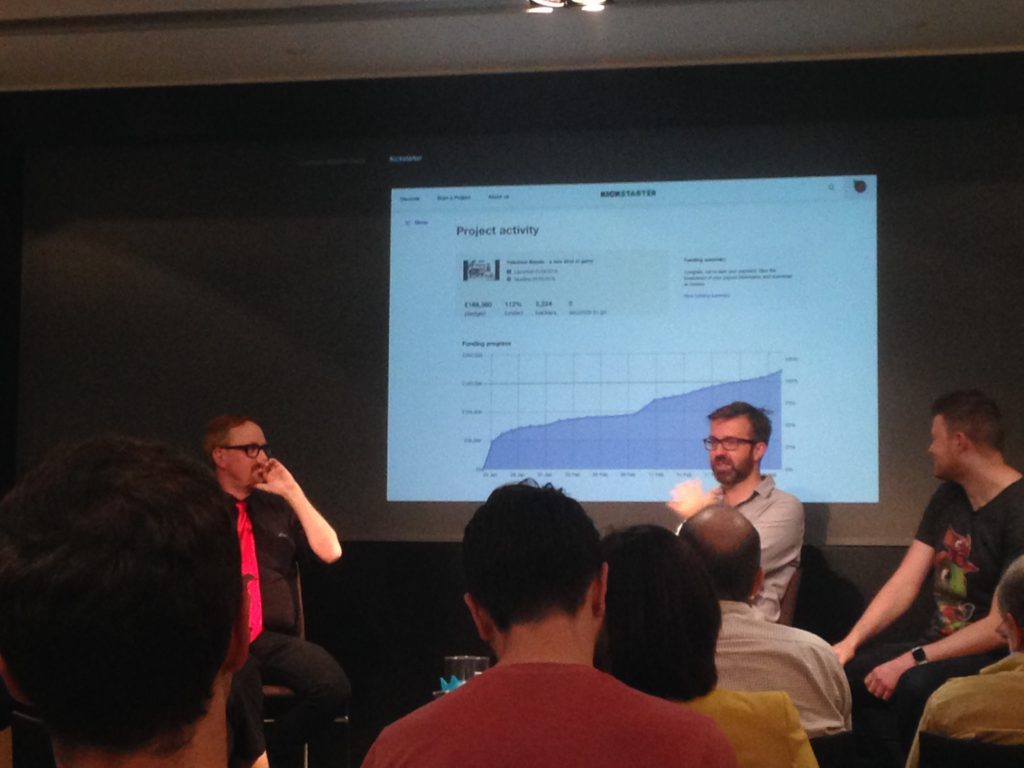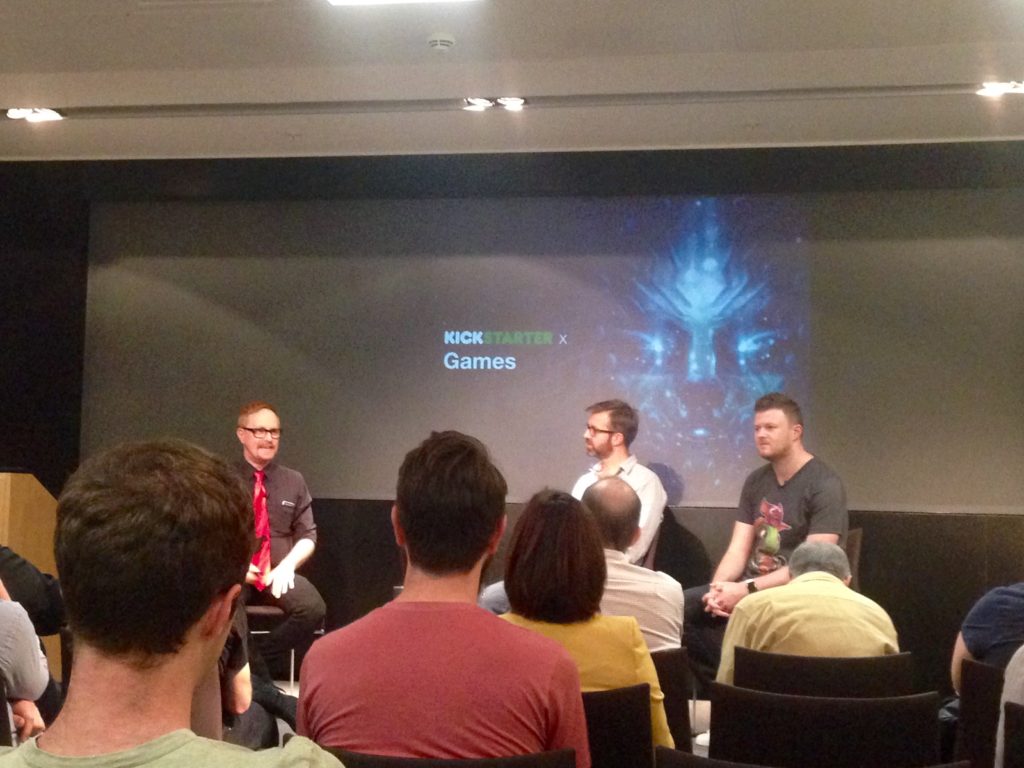For the benefit of those who didn’t make it, here are my notes from the Kickstarter: Making a Game event held at the Guardian on 14/07/16. I’ve tried to attribute comments with colours—what lawks!
(I’m guessing any suspiciously round figures given were approximate.)
Speakers:
Luke Crane – Head of Games, Kickstarter
Alex Fleetwood – Founder, Sensible Objects, Beasts of Balance
Gavin Price – Managing Director & Creative Lead, Playtonic, Yooka-Laylee
- Games are the biggest Kickstarter category by dollars pledged.
- 8100 games have been successfully funded, with $512 million pledged.
- 2.2 million people have backed a games project.
- 1.3 million have backed a video game project
- 1.2 million have backed more than one game project.
- The most popular reward tiers are:
- $75 for board games
- $45 for computer games
- $100+ for games hardware
- (The averages are higher, but skewed by big backers.)

- The middle bit of the funding curve is called the ‘Plateau of Despondence’.
- Yooka-Laylee (YL) didn’t really have a plateau—it just kept climbing.
- Prior to launching the YL Kickstarter campaign we built hype; we announced the formation of Playtonic (which was initially comprised of several guys from Rare) in Edge magazine, announced the Kickstarter at a London Games Con, and revealed the games’ characters just before the Kickstarter launched.
- The YL campaign focused on $10–20 rewards.
- Your campaign video needs to address what the game will do and why you need the money.
- People tend to be suspicious if your campaign is too slick.
- Sensible objects aims to blend software and hardware, to ‘reinvent board games with tech’, inspired by the ‘golden age’ boom. Board games use the common technology of cardboard in amazingly versatile ways.
- Beasts of Balance (BOB) should be out in time for Christmas. Nothing has exploded yet.
- The BOB campaign raised £168,360 from 2224 backers. We needed £150,000 to placate initial investor backers and cover tech costs.
- Our Kickstarter campaign involved one year of prep for one day of launch. Building mailing lists, getting reviews, etc.
- Pricing is more important than marketing.
- Arts and corporate funding is harder to come by these days. Kickstarter is changing things.
- Sometimes you see special ‘early bird’ reward tiers. Don’t do this—we lost potential backers this way as those who missed the early bird feel they’ve missed out. The earliest backers are the most invested (and very possibly related to you) and are thus happy to pay.
- Trust is more important than vision.
- Anything you don’t know can be found out. People will uncover your mistakes and omissions.
- A Kickstarter campaign is a dialogue you have to lead. We designed a thing and people didn’t like it so we revised it and they were happy.
- Make your thing real (i.e. with a demo).
- Remember the silent majority. It’s easy to worry about the 10 vocal backers and ignore the other 2000.
- Everything you say is a promise to thousands.
- We had a stretch goal that said there would be ‘fur, scales, horns’ and people were asking ‘where’s the fur?’ when it didn’t appear.
- We stopped adding stretch goals to keep the project achievable. It’s easy to fall into ‘feature creep’.
- Kickstarter is disruptive, you wouldn’t usually involve your audience so early in the game development process.
- A lot of people will be watching your campaign…
- We had industry and suppliers contacting us in droves.
- … but a lot more people are not watching your campaign.
- YL had 73,206 backers, raising £2,090,104.
- Do your research, especially with physical things and rewards. We’ve had 20 guys sending out 10,000 t-shirts, which is a logistical challenge.
- Our team was initially formed by a bunch of guys from Rare—veterans who brought that heritage with them.
- We’ve grown from 7 guys to 20 people.
- We went dark once funded to do a big, impressive reveal about a year later, rather than delivering in a trickle.
- YL is the most successful UK video game Kickstarter campaign.
- It was the most successful UK game, but the Dark Souls board game beat it recently.
- Be transparent with your audience.
- The prototype is important.
- Be seen to be doing it right. We gave the one-year-on reveal to a magazine, but gave a heads up to the backers first so that wasn’t the first they heard of it. Press haven’t been allowed to play the game before backers.
 Questions:
Questions:
- How many games get funded?
- Success rate for games on Kickstarter is 34%.
- You hear a lot about projects that don’t deliver…
- 90% games projects deliver all promised rewards.
- Perhaps some of those failures were Kickstarter pioneers. We now know that physical goods can be a problem, but we’ve learnt that from earlier campaigns. It’s an evolving process.
- Double Fine have succeeded in reviving their genre. Is that what YL hopes to do?
- YL’s success and Ratchet & Clank show there’s a market. It’s hard to know why these games vanished—perhaps it was the advancement of technology and inevitable increase in realism.
- What matters for us is the final game. We pushed the release back six months to finish it properly.
- What support is there for people who want to run a Kickstarter games campaign?
- There’s two people on the games team at Kickstarter; we’re happy to help but there’s lots of resources online.
- Is a Kickstarter campaign harder than pursuing traditional funding?
- We raised seed funding for BOB, for hype and the prototype, which helped.
- 54% of tabletop games get funded. There’s a big boom in tabletop at the moment.
- For tabletop Kickstarter campaigns there’s a common process; you make a prototype and show it round to people before doing the campaign. This bit’s all sweat, then your campaign is to get money for the manufacturing. You make your money through sales.
- Community is key for tabletop—it’s a great community that’s often happy to advise you.
- Go team tabletop!
- Is there a movement towards bringing digital and physical together?
- I’m a bit biased, what with BOB, but yes.
- Tabletop games have been resistant to digital aspects. We had to tackle this with BOB, to find credible people within the community to advocate us.
- The costs and accessibility of tech have come down, with Arduino, Unity, and 3D printers.
- Is there a good time of year to launch a Kickstarter campaign?
- Data’s spotty, and the aggregate doesn’t inform your project. Don’t launch at Christmas, though, because nobody will have any money. We launched in February for Christmas rewards.
- One guy launched on 4th July, against advice, and nobody was at their computer because they were all at barbecues! But Elite Dangerous launched at Thanksgiving. Rules are there to be broken.
- How often should campaigns communicate with backers?
- YL was a bit odd. We didn’t want to show wireframes and pictures every week—we did’t want people to get bored. We sent out monthly updates but no pictures of the game, to wow people a year later.
- BOB sends three updates a month on average. We can showcase the guts of the process, such as China factory visits, and tell a story with it, which appeals to people.
- Most successful campaigns update every two days whilst live.
Final Thoughts:
- Make promises you can keep.
- Games are fun!
- Making games can be the least fun.